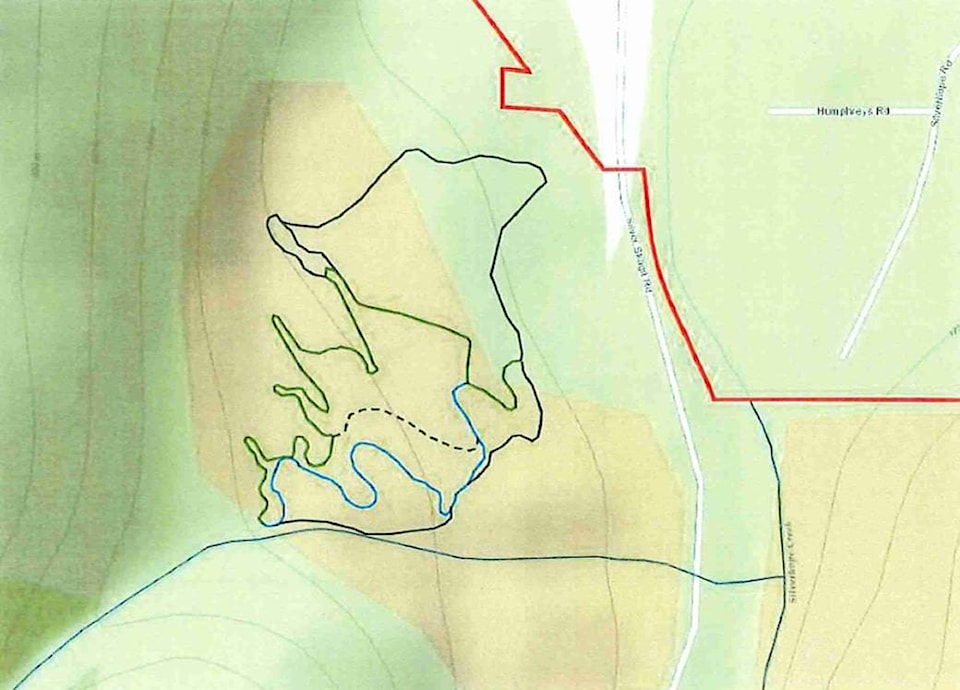Hope may one day draw people from around the province and beyond for mountain biking, yet lots of work is needed to get there said mountain biker Michael Woods.
Woods, vice president of the Fraser Valley Mountain Bikers Association, updated council July 27 on the progress of trail development in Hope. Trail building for the time being is focused on locals, yet may one day expand to draw in visitors.
Mountain bike trail building is happening this summer in the Silver Creek area adjacent to the Silver Skagit Road, what is known locally as “the core.” The work is happening near where the Hope Mountain Centre for Outdoor Learning is also busy constructing the ‘Dragon’s Back’ trail this summer.
A.J. Strawson of the International Mountain Bike Association designed and GPS mapped trails in this area with $3,100 in funding for this work flowing from the Cascade Lower Canyon Community Forest. Trail construction in this area started in late May, with the help of wildfire crews from the Haig fire base. “They’re using this as a training tool for them, because they didn’t have the work at the time with the wet June that we had,” Woods said.
Many of the firefighters are mountain bikers themselves, Woods’ report to council read, and volunteered to help build trails together with Hope area trail builders. The trail build requires woodwork and ‘extensive bridge work’ the report read, in order to connect large boulders.
The community currently doesn’t yet have any legal mountain biking trails, Woods said, yet it is something they are working on. In the province, groups have to apply to the government for authorization to build trails on crown land as per Section 57 of the Forests and Range Practices Act. The group has gotten authorization for trail building in the core, and will seek another authorization to build trail in an area off of the Mount Hope Forest Service Road.
This was an area identified by Strawson as an ideal place to put a trail network. He has since GPS mapped and flagged this area for future trail development.
Read more: New hiking trail to be built overlooking Hope
Woods stressed that these trails will be multi-use, allowing dog walkers, hikers, trail runners and others to use the trail network. “Any area where there can be any sort of conflict, we’ll have reroutes,” Woods said. “So on tighter areas where mountain bikes may be coming down relatively quick, we can have a reroute to allow for safe passage of…any hiker or foot traffic.”
Building Hope’s mountain bike infrastructure is about expanding recreational opportunities, Woods said, and attracting a younger demographic to town as well as mountain biking tourists.
Building walking paths and trails has been a focus for the community, and funding from the community forest has been focused on these projects, Woods said. While these are good community assets, he added, “you’re not going to draw the tourism and younger generation of people moving to your community as much.”
The end goal for the area around the Mount Hope Forest Service Road is to have a mountain biking trail that rivals Whistler’s 32-kilometre alpine trail and Silverstar mountain resort’s 35-kilometre trail. The Hope loop, which could be around 30 kilometres if an alpine loop is included, would be “an extensive ride” drawing people from far away Woods said. Next steps for this include securing Section 57 authorization, funding and support from various governments and organizations.
The success of Squamish was referenced several times by Wood. That community has seen an economic boom from the building of both walking paths as well as mountain bike trails, the latter of which draw tourism to the community.
A 2007 economic impact study of mountain biking in the Sea-to-Sky corridor found 8,000 to 76,000 riders flocked to the communities along the corridor stretching from North Vancouver to Whistler. In Squamish, 21 per cent of visitors surveyed stayed overnight and spent an average of 3.6 nights in the community and each biker spent around $92 per day.
“You go mountain biking in Squamish on any given day and there are hundreds of cars from out of town there and the local breweries are jam packed with cars with mountain bikes on them,” Woods said. “It’s a pretty good atmosphere. And that’s what we’re trying to build in Hope.”
Mayor Peter Robb noted the recently completed 2019 Fraser Valley Regional District economic impact analysis and the finding that mountain biking was a lesser draw to the area’s communities than other outdoor activities.
Mountain bikers who did make it to the regional district areas spent an average of 2.7 nights in the area, with an average of 2.8 people per group with most being intermediate to advanced riders the report found. These groups spent an average of $1,232 per group per trip if they were visitors from outside the area.
Related: B.C.’s best bikers crank out top spots at Crankworx
Do you have something to add to this story, or something else we should report on? Email:
emelie.peacock@hopestandard.com
